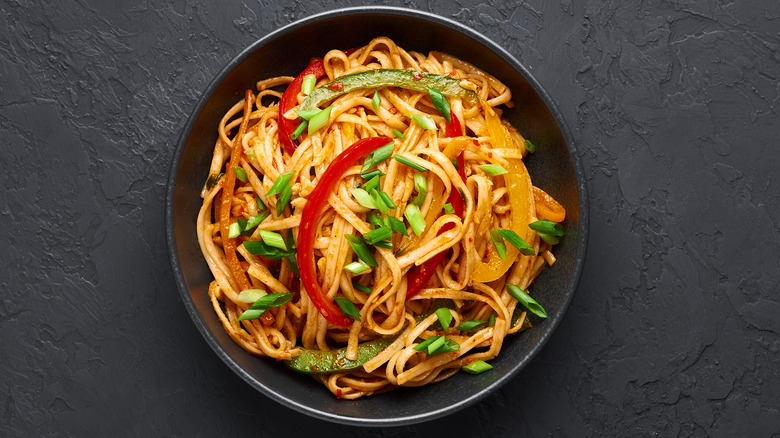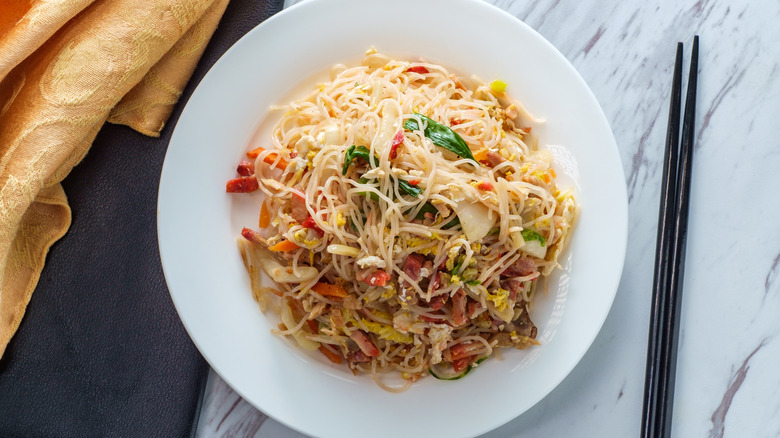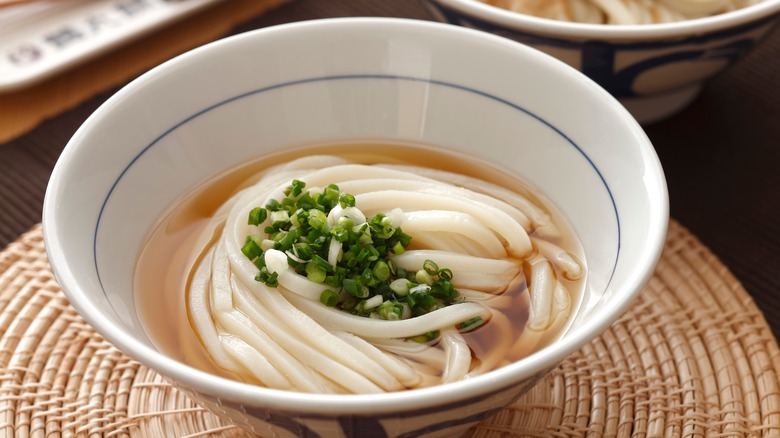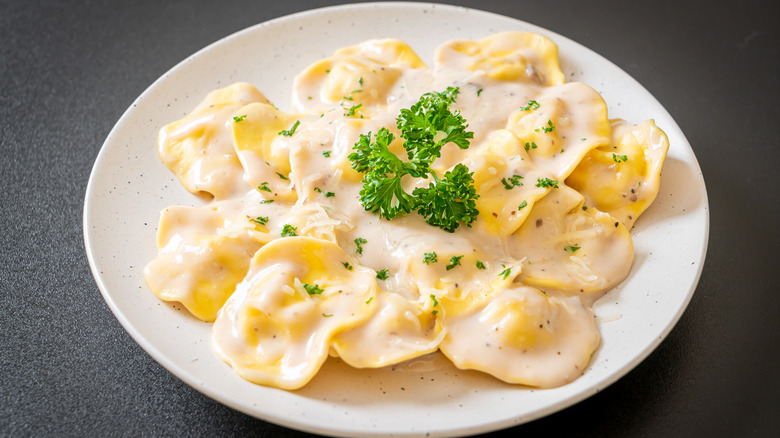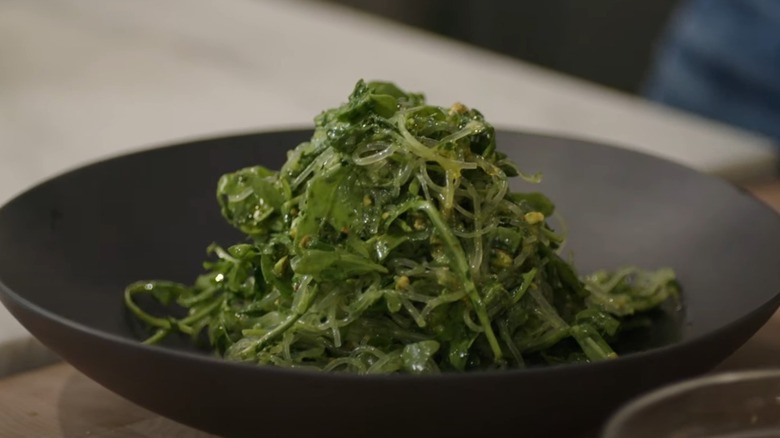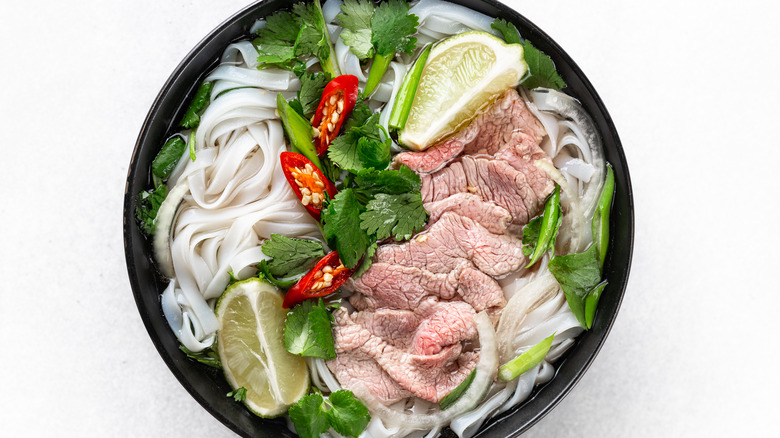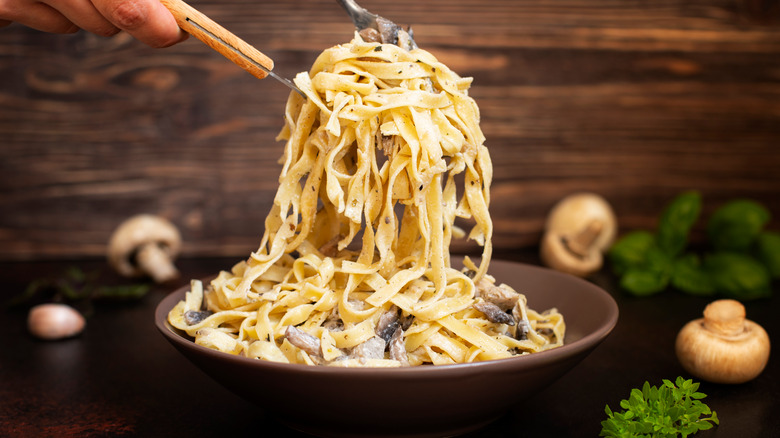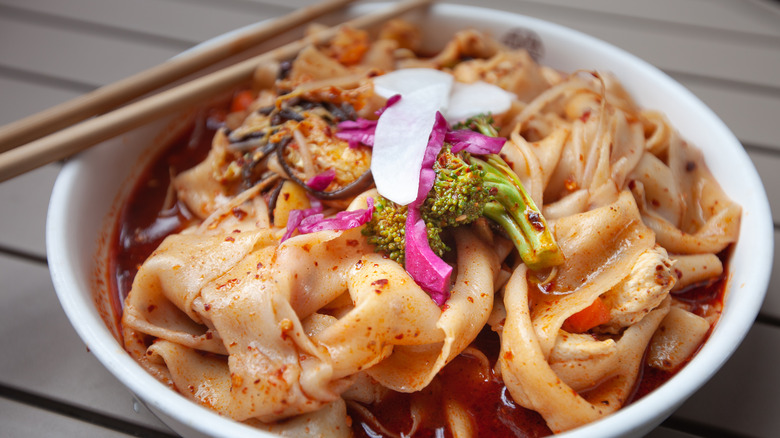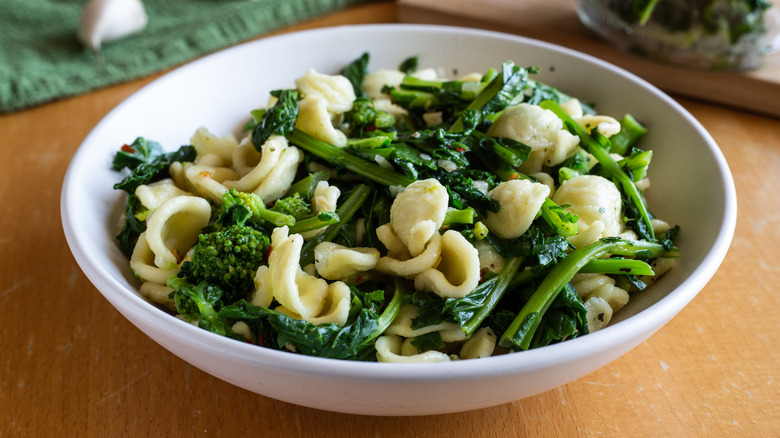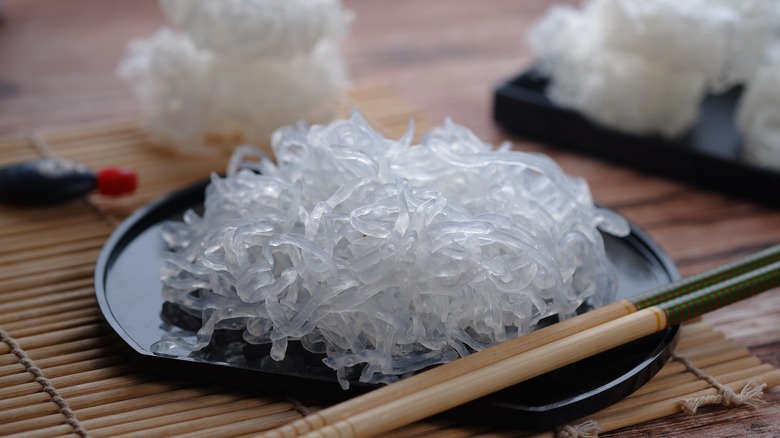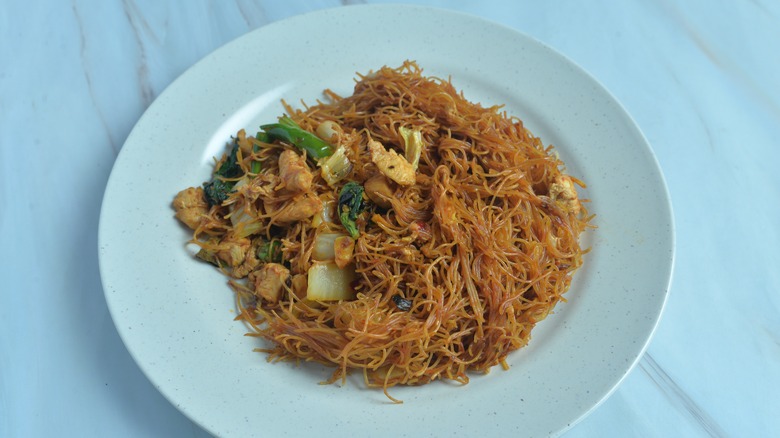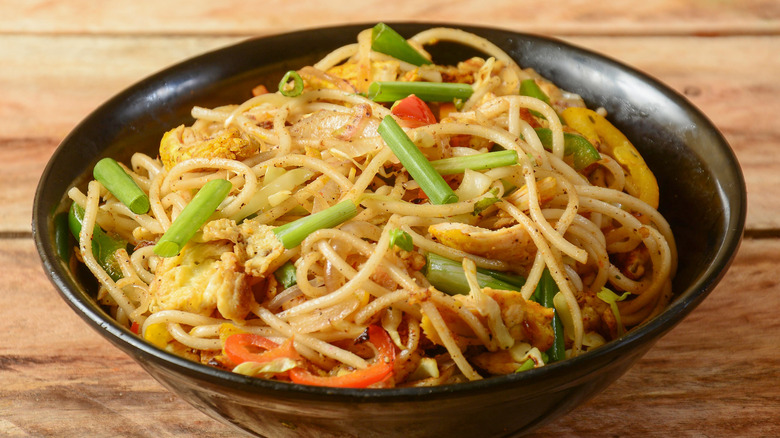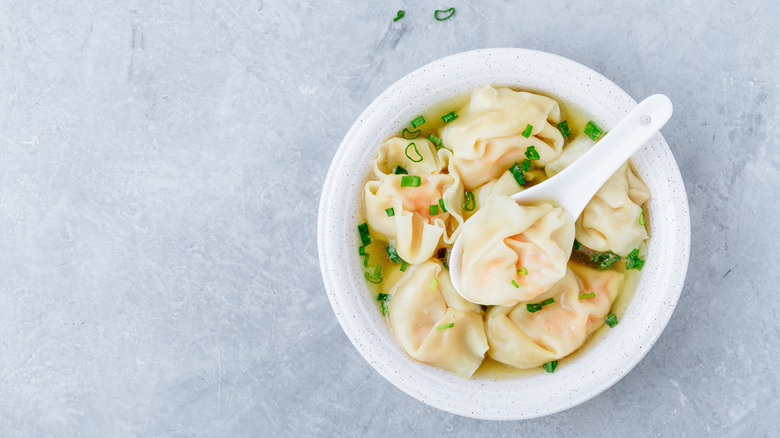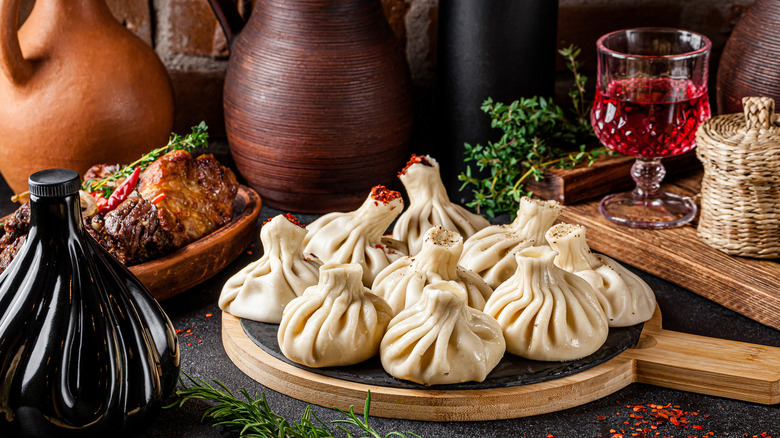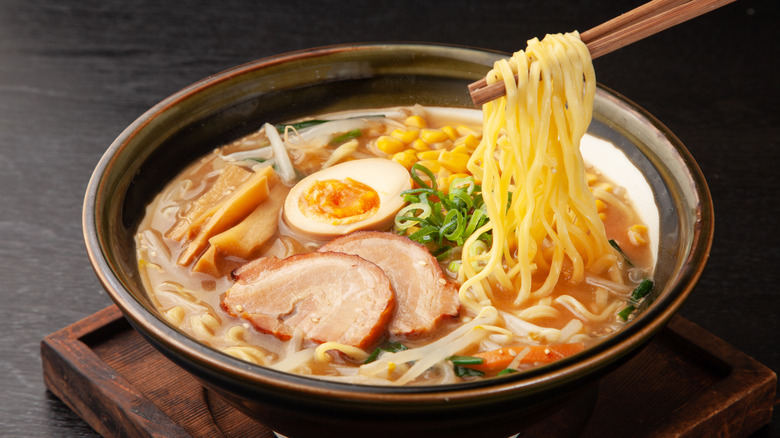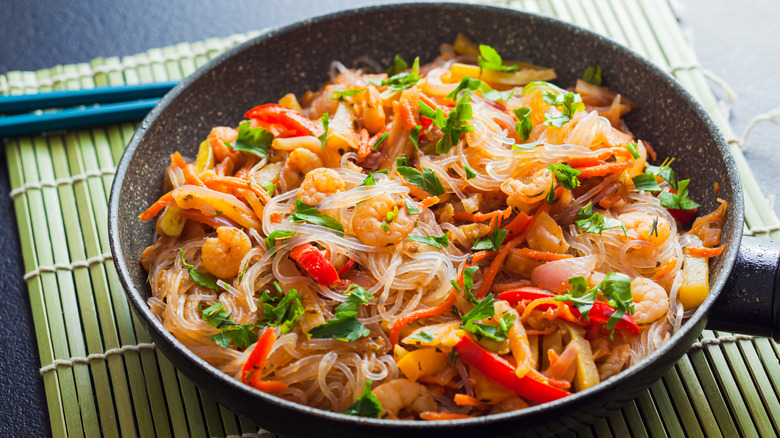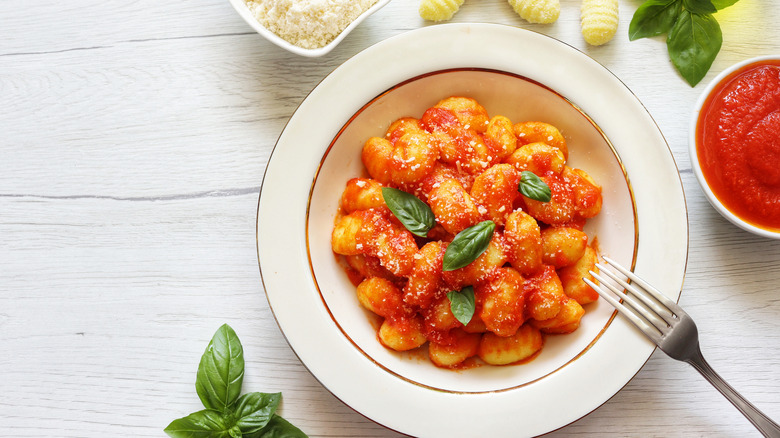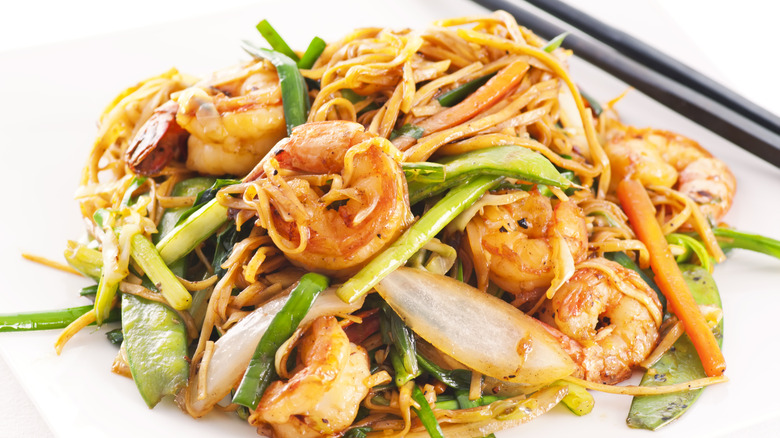17 Types Of Noodles And How To Cook Them
There aren't too many comfort foods on the planet that can compare with a steaming bowl of fresh noodles. Whether bathed in delicious stir-fry sauce and studded with vegetables or served piping hot in a fragrant broth, noodles are hearty, accessible, and nearly universally adored. However, while noodles can be a quick and easy meal addition, cooking them properly is sometimes a tricky business.
Not all noodles need the boiling water treatment, and cooking times almost always vary from noodle to noodle. So if you want to avoid winding up with a gloopy mess of overcooked starch rather than a silky, slippery, tasty bowl of delicious noodles, this guide can help you up your game and nail your noodles every time. Also, don't be afraid to think outside of the spaghetti box. From mung-bean-based glass noodles to glorious kelp-based treats from the sea, there's a galaxy of delicious noodle options just waiting to be explored.
Mei fun
Although Han Chinese people started the mei fun noodle trend, it's since spread throughout much of Asia, and these thin rice, or potato flour, threads are popular and accessible throughout that part of the world. According to China Sichuan Food, savvy cooks can stir their noodles into tasty Hunan-style mei fun soup or toss them into a Singapore-style stir-fry. All you need is a little bit of prep work and a keen eye for knowing when the noodles are done cooking.
To make authentic and delicious mei fun stir-fry, simply give your delicate noodles a brief boiling water bath before tossing with sauces, meats, and veggies. Just about two minutes will do the trick nicely. You don't want to overcook these morsels. Make sure you drain your mei fun noodles thoroughly to avoid soupy sauces, and you're ready to enjoy an easy weeknight meal that's lightyears ahead of take-out in deliciousness and authenticity. Try this quick pork mei fun recipe for a tasty dinner.
Udon
Udon is a hearty, heavy type of noodle that's usually swirled into the bottom of a soup bowl or eaten cold with plenty of spices and vegetables in Japanese cooking. It's one of the most ubiquitous and easy-to-incorporate noodles, and you can toss it into fragrant soups, salads, or fiery stir fries as a glutinous and filling alternative to rice. Udon noodles are wheat flour-based (via BBC) and relatively easy to cook. Just toss your udon in boiling water, give them a stir, and boil once more after infusing the pot with cooler water. This double-boil technique will yield perfectly springy, chewy noodles.
Udon pairs perfectly with fish and seaweed broth or some fresh ginger, vegetables, soy sauce, and a sprinkle of sesame seeds. Udon's doughy and fairly neutral flavor makes it the ideal foil for more robust ingredients and something you'll want to perfect if you dabble in Asian cuisine.
Ravioli
Whether fresh or frozen, there's a good chance that you've tried your hand at cooking ravioli at least once or twice. This popular pasta only requires a scant few minutes in boiling water, making it super easy to overcook. According to Livestrong, cook fresh ravioli for two minutes and frozen ravioli for between four and six minutes. Since you're dunking the ravioli in an ample pot of boiling water, you don't need to defrost the frozen stuff.
For ultimate ravioli success, you'll need at least four quarts of salted water, though you can use up to six quarts. Ravioli likes its space, so make sure that you don't overcrowd the pot unless you want a glutinous mess. It also pays to expand your horizons beyond standard meat and cheese fillings. This homemade lobster ravioli recipe puts a sumptuous and sophisticated spin on the humble pasta pockets and is fit for any high-class dinner.
Kelp noodles
Kelp noodles are a fantastic choice for people who follow low-carb or gluten-free diets, and these super tasty, ultra-slim noodles pair perfectly with cold Asian-inspired salads, vegetables, tofu, and meat. Best of all, you don't even need to cook these Ketolicious noodles in any traditional standard fashion. Instead, simply soak them in hot water, and you're ready to go (via WikiHow).
How long you soak your kelp noodles depends on the texture you're going for. Six minutes is optimal for heartier, crisper noodles, while 10 minutes yield pliable, soft noodles. Never boil kelp noodles in a pot or even run boiling water over them. Overcooking makes them mushy and unappetizing. If you're looking for a great weeknight meal in line with a Keto diet or a tasty dish that won't trigger a wheat allergy, while still giving you plenty of nutrients and taste, reach for the kelp noodles.
Rice noodles
Mastering the art of the perfect rice noodle can be tricky, but once you get it down, you'll be ready to enjoy these gluten-free, versatile, and delicious noodles in no time. According to Bon Appétit, you cook cold rice noodles for slightly longer than hot ones, and it's essential to follow the package directions to the letter. Going rouge with rice noodles will land you with chewy, unappetizing, overcooked noodles.
Since they tend to get glutinous and sticky, it's a good idea to give your noodles a quick rinse, so they don't mash up together. Once you nail the process, you're ready to toss these yummy noodles in soups, salads, or tasty stir-fries. There are a host of different rice noodle dishes, so don't be afraid to go big and bold with your sauces, vegetables, meats, and garnishes. Think of them as the ideal canvas for all of your robust culinary creations.
Fettuccine
One of the most popular kinds of pasta in the world (via CBS19), fettuccine is a broader, heartier version of spaghetti and the base of classic Italian dishes like Fettuccine Alfredo. According to Forbes, Fettuccine Alfredo is a masterclass in minimalist cooking, and it sings with simple, high-quality ingredients paired in perfect harmony. All you need is cooked fettuccine, some premium parmesan cheese, and a bit of butter. Although some restaurants stir cream into the sauce, traditional Italian cooks opt simply for butter, cheese, and pasta.
Cooking your fettuccine correctly is the first step to crafting a fantastic pasta dish. Boil a generous amount of water, throw in a few pinches of salt, and cook your fettuccine for roughly 10 minutes. Clever cooks know that a little starchy pasta water can go a long way to making classic dishes like Chicken Fettuccine Alfredo multi-layered and delicious, so make sure you save a bit for the sauce.
Biang biang
According to the BBC, the Chinese character for "biang" isn't in any known dictionary, making these biang biang noodles a culinary curiosity whose name refers to an oddly specific sound: dough smacking onto a surface. The mysterious name is almost certainly influenced by the act of making biang biang noodles, as these lengthy, doughy creations need many thwaps to transform into the thick, delicious noodles that are one of the cornerstones of Shaanxi province's cuisine.
Although the enigmatic noodle doesn't technically have a name, it is becoming more ubiquitous around the world, and you can make them yourself with a little elbow grease and some skill. According to Red House Spice, biang biang noodles are a delicate mixture of cake flour and water that you need to knead, wait for 10 to 15 minutes, and knead again. Then, once your biang biang has that coveted elasticity, press the dough into a rectangular noodle shape, dunk them into boiling water for a scant minute or so, and serve them piping hot.
Orecchiette
Tiny, ear-shaped orecchiette pasta is the perfect vessel for hearty sauces and vegetables. Thanks to its unique, shell-like design, dainty orecchiette is highly adept at scooping up all the good stuff from your plate in every bite. According to Italy Magazine, these morsels harken back to the 12th or 13th centuries and are a local favorite in the Italian town of Bari. They are a simple mix of water, salt, and flour and are hand-pressed into the iconic ear shape.
Try your orecchiette with turnip greens or fresh tomato sauce, or you can make Stanley Tucci's iconic orecchiette dish with broccoli rabe and plenty of garlic. Orecchiette tastes best when it's al dente, leaving those little shells strong enough to collect all the goodness from the sauce. Drop your orecchiette into a pot of salted, boiling water with plenty of room for them to cook properly, and make sure that you save some pasta water for your sauce.
Shirataki
Simple shirataki noodles have just two ingredients: konjac starch and water. As noted by Medical News Today, these noodles are sometimes called "miracle noodles." It all starts with yam starch that are forged into bricks of konnyaku, a robust alternative to meat. Thanks to its gelatinous but firm constitution, Konnyaku blocks can also be sheared into thin noodles or shirataki. Shirataki has a neutral taste and a pleasant texture, but what really sets it apart is its high glucomannan content, a good-for-you fibrous starch.
According to Bon Appétit, you can cook shirataki in a matter of minutes. Pop your shirataki into a pot of boiling water with a bit of vinegar for roughly three minutes. You can also stir-fry shirataki. Since shirataki absorbs plenty of flavor as it cooks, stir-frying it in sauce or an aromatic combination of garlic and vegetables can lend layers of flavor without too much effort.
Vermicelli
Lanky, long vermicelli bears a strong resemblance to more popular spaghetti. Boil wheat vermicelli for eight to 12 minutes in salted water (via Livestrong), or soak delicate rice vermicelli in boiled water for a few minutes before pan-frying it with peppers, green onions, and more. Vermicelli is endlessly versatile, too, pairing beautifully with delicate or robust sauces and playing a supporting role in spicy stir-fries or cold salads. If you need a tasty, quick carb to round off your dinner plate, reach for the vermicelli.
According to NDTV Food, vermicelli's origins are slightly murky. Depending on who you ask, these noodles might have their roots in Italy or China. While it's difficult to pinpoint precisely where vermicelli came from initially, the pasta is ubiquitous and loved in virtually every corner of the world, showing up in Southeast Asian stir-fries, Italian pasta dishes, traditional South Indian cuisine, and even Persian desserts.
Chow mein
Like many great foods, chow mein's origin story varies from place to place depending on who you ask, although there's a fairly general consensus that it came from Northern China (via Taste Atlas). Traditional chow mein is deceptively simple, relying on the power of fresh ingredients and a classic preparation. Essentially, it's a combination of meat, sauce, vegetables, and noodles. The crunchy and chewy texture of the chow mein, fragrant sauce, and hearty combo of mushrooms, cabbage, and fresh bean sprouts yield a variety of different tastes and textures.
Chow mein has evolved over the years, and many American versions are lightyears away from what you would find on the streets of Beijing. Still, you can make your own dish at home with a few simple ingredients, a wok, and a quick chow mein recipe. Let the chow mein noodles drain thoroughly so they crisp up nicely in the frying pan and give you that glorious interplay of textures.
Wonton
According to the South China Morning Post, the best bowls of wonton noodles hinge on a few critical ingredients: thin noodles, delicate wonton wrappers, shrimp, a hearty broth, and a few light garnishes to tie the whole dish together nicely. Nail the combination, and you have yourself a richly flavored meal that hits notes of both haute cuisine and home cooking. Although prawns make the most traditional and arguably tastiest filling for wontons, you might also stumble across a pork one here and there.
At their core, wontons are a type of dumpling, meaning you need a perfect ratio of filling to dough. Add too much filling, and your wontons could burst. On the other hand, too little filling will yield clunky and gelatinous wontons. Once you've got your wontons down pat, cooking them is a breeze. Simply follow a wonton soup recipe, and simmer the doughy gems in broth and aromatics for about 15 minutes.
Khinkali
Khinkali – hearty little pouches full of meat, aromatics, and soup — are some of Georgia's most treasured culinary offerings. According to the BBC, khinkali might have emerged as convenient, filling shepherd fare in the frigid hills of Tusheti. However, several different parts of Georgia claim these dumplings as their own. Today, khinkali is nearly universally available in Georgia, with an intoxicating mixture of meat and spices and some water to form the soupy interior base.
Like most dumplings, the ratio of dough to filling is vital. Since khinkali has a wet filling, it's even more critical to get the right thickness so they don't explode or disintegrate in the pot. Don't go too far in the other direction, though. Too-thick khinkali can be gummy. Once you have your perfect pouches, cook for roughly 13 minutes in boiling water (via Georgian Recipes). Also, observe proper khinkali etiquette, using your hands only and drinking the hearty soup mixture first (via CNN).
Ramen
Authentic ramen noodles are a far cry and a considerable upgrade from the bricks of sodium you find at your local 7-Eleven, and learning to cook them properly is an easy-to-learn and valuable skill. According to Yamato, it's essential to start with a vigorously boiling pot and keep stirring your ramen. Leaving them unattended will land you a sticky clump of noodles instead of silky strands of ramen. Keeping the water consistently boiling is also essential.
Once your ramen is cooked, it's time to add in the fixings like soy, miso, and vegetables. Gently fill your ramen bowl with fragrant broth, and you're ready to feast. Proper ramen is meant to be eaten with gusto (via Smithsonian Magazine), which means tons of satisfied slurping, so don't be afraid to show pure delight while wolfing down your bowl. Once you've tried real ramen, you'll never want to return to the fake stuff again.
Glass noodles
Glass noodles, or bean threads, are delicate and transparent strands of mung-bean-based deliciousness. According to The Pioneer Woman, you can either boil them for a few minutes or soak them in steaming water for roughly 10 to 15 minutes until they become pliable. Uncooked glass noodles are white and coarse but transform into silky clear strands when cooked, making the perfect addition to your favorite stir-fry or bowl of hot soup.
Glass noodles are naturally gluten-free and act as tasty little sponges, absorbing tons of flavor almost instantly. Since they're more neutral-tasting, you can pair glass noodles with more assertive sauces and flavor combinations. Rest assured that they'll add a welcome touch of texture and heft to the dish without clashing. These noodles are a fantastic addition to any properly stocked pantry because they're super easy to cook and are one of the most versatile noodles out there.
Gnocchi
Rich and robust gnocchi is Italy's nod to the dumpling. Good gnocchi has a light, creamy texture that works well with basic butter sauces or stronger, heavier fare, and you can get it from the pot to the table in just a few minutes. According to Saveur, gnocchi comes from Italy but varies from region to region and has deep roots that date back to the 1500s. Venetians call gnocchi "macaroni" and serve up a baked riff on the classic dish, oozing with butter. Whether you like your gnocchi coated in oodles of buttery goodness or served fresh with basil and bright tomato sauce, it all starts with perfectly cooked dough.
The key to the dish's success in this potato gnocchi recipe is frozen dough and salted water. Drop your gnocchi into the water and wait until they pop back up to the surface. Once they're floating, get them out immediately and dress them up however your heart desires.
Yi mian
According to some origin stories, yi mian noodles might hark back to Emperor Wu and the Han Dynasty, who first jokingly made the connection between longevity and noodles based upon the similarities in words for "face" and "noodles" (via KQED). As a result, yi mian holds a special place in the hearts, and at the tables, of many Chinese people, and these meter-long noodles should never be cut before being consumed.
Treating yi mian with the reverence they deserve also means cooking them correctly. According to the Vegetarian Times, cook yi mian in boiling water for less than 10 minutes before fully draining. You can also stir-fry fresh yi mian for about two minutes with some softer vegetables and sauce. According to Gourmetpedia, you shouldn't fill your bowl to the brim because that means you're completely satisfied with your life. Instead, leave a little bit of room for the blessings to come.
